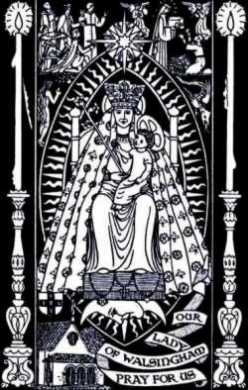The west entrance, gallery and rose window

Our Lady of Lourdes greeting visitors

Bronze door to the north transept

Our Lady of Lourdes again and her waters as ...
 St Bernadette kneels in adoration
St Bernadette kneels in adoration
The real high altar, sadly disused


The disused pulpit, with the unattractive
(and theologically questionable) Cross of the Millenium

The new bishop's cathedra,
complete with plush golden carpet and a gold lamé curtain behind

Looking west

The 12th station

Windows in the south transept

The south gallery windows

The Nativity, from the north transept

The west rose window, with angelic musicians

Looking east, with the incongruent modern altar and canopy and hideous blue carpet


The new font continually pouring the waters of life down a plastic slide

The original cathedra remains in the narthex to tease the visitor

A beautiful western icon of the crucifixion in the new elevator pavilion

In the darkened parish hall in the undercroft, treasured relics of a better age await the restoration of these things to their proper place in the church.

Earlier last week, while travelling on an extended holiday between two family weddings, I visited this nice surprise of a cathedral in Spokane, Washington, but for the reordered bits.
Perhaps most disturbing was the Cross of the Millenium where a lasered-image of the risen Christ is literally embedded within a Lucite cross. How is this a positive image of Our Lord's passion? At best it seems to take too far the orthodox idea of the corpus and cross being one image and inseparable. Perhaps it's an interesting thought to consider the passion of Our Lord transferred into the wood of the cross on which he hung, but it was revolting to see this image in person.
From promotional material on the Cross:
'The Cross of the Millenium is a transcendental masterwork of historical and spiritual significance. Frederick Hart has "sculpted with light" the embedded Christ figure, seen through the faceted Star of Bethlehem. This work marks the first time the birth, death and resurrection have been simultaneously depicted in a single work of art. The Cross represent the mystery of life and spirit and is a powerful symbol of peace, hope and the brotherhood of man, transcending religious boundaries. ... The Cross will be a continual reminder that Christ is the Light of the World and through Him we are connected to all people.'
Now I shouldn't be too hard on them, or go on at length about it. However, it mirrors the other distortions seen in this cathedral and across the land, where the holy and sacred has been transmuted into something trite, self-serving, often aesthetically tasteless, and worse, reflecting a severe lack of pastoral guidance and teaching. When history is destroyed and altars disrupted, is this an image of the desolation of Jerusalem?
It must be our job now to incorporate all things at hand, in a miracle of post-modern synthesis, to recapture the old, not lose the new (or else risk another rupture) and bring afresh the Good News of Christ to all whom we encounter, which has been alive through all time in the faithful, and which we must entrust to those who follow.


_Black_s_s_s_s_s.jpg)
